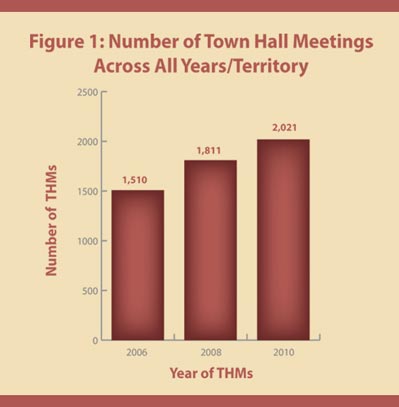
Underage Drinking Campaign: Local Communities Take Active Role
This fall, SAMHSA plans to launch "Talk. They Hear You."—its third National Underage Drinking Campaign. With the help of a panel of experts to guide research, objectives, and strategies, SAMHSA has focused the campaign on engaging parents of youth ages 9 to 15 in prevention behaviors and motivating them to talk to their kids before there is a problem. The campaign aims to provide parents with practical advice, information, and tools to support their role as influencers on their child's decision not to drink.
Drinking alcohol under the age of 21 is illegal in the U.S., yet according to SAMHSA's National Survey on Drug Use and Health (NSDUH), in 2010, approximately 10 million youth ages 12 to 20 reported drinking alcohol in the past month. Underage drinking increases the risk of academic failure, illicit drug use, and tobacco use. And as a leading contributor to death from injuries for people under age 21, underage drinking continues to be a public health concern with serious consequences for youth, their families, and their communities.
In 2006, Congress passed the Sober Truth on Preventing (STOP) Underage Drinking Act that requires the U.S. Secretary of Health and Human Services to establish and enhance the efforts of the Interagency Coordinating Committee on the Prevention of Underage Drinking. It is through the STOP Underage Drinking Act that SAMHSA's Underage Drinking Prevention National Media Campaign is mandated.
Research and Testing
Drawing on the key findings from extensive formative research—focus groups, interviews, and surveys—SAMHSA developed radio, TV, and print public service announcements (PSAs). SAMHSA is conducting pilot campaigns in each of the five National Prevention Network (NPN) regions in order to test materials in the community and provide feedback prior to the national launch. Each pilot site has strong local community connections.
"We're hoping that the materials will be received well by the diverse communities that exist in that one location. That's very meaningful from a community standpoint because you really are trying to raise awareness," said Edwin Chandrasekar, Executive Director of the Asian Health Coalition (AHC), a pilot site for the Central NPN region. The AHC serves Asian-American immigrant and refugee communities in metropolitan Chicago. To make the campaign more relevant to the large Chinese population on the north side of the city, AHC had the print materials translated into Chinese. AHC collaborated with local youth and businesses such as grocery stores and restaurants to distribute print materials. They also engaged local media to air the PSAs and conducted a town hall meeting on May 21 to introduce the campaign to the community.
Town Hall Meetings
All pilot sites selected to test the Underage Drinking Prevention National Media Campaign materials conducted at least one town hall meeting to raise awareness about the campaign and to mobilize the community around prevention efforts. Since 2006, SAMHSA has sponsored town hall meetings in alternating years to educate community members about the consequences of underage drinking; empower communities to make environmental changes to prevent underage drinking; and mobilize communities around prevention initiatives at the local, state, and national levels. Each year the number of town hall meetings has steadily increased, with youth engagement and participation playing a central role.

New for 2012, SAMHSA has introduced a series of training webinars to address topics such as maximizing community and media support for town hall meetings and encouraging youth leadership and participation. For more information, please visit www.stopalcoholabuse.gov/townhallmeetings.
For SAMHSA, the next steps before launching a national campaign will be to evaluate feedback from the pilot sites on the effectiveness of the communication materials, PSAs, and activities. This feedback will help shape the focus for the national campaign strategy.
Below are some pilot site activities unique to each NPN Region:
Northeast: Erie County Council
The Erie County Council leveraged its relationship with the local school boards to pilot the campaign in parent forums. The Council also used the school-based online parent portals to post campaign materials.
Southeast: Metropolitan Drug Commission
The Metropolitan Drug Commission used Facebook and Twitter to engage the public during a Town Hall Meeting that was aired live on TV and online. Forum leaders read questions and comments from the social media sites. Designated employers inserted a campaign flier into paycheck stubs to reach parents at least twice a month.
Southwest: Summit Prevention
The Summit Prevention engaged parent networks to plan an alcohol-free after-prom party at a local recreation center complete with a hypnotist, DJ, and casino. The parent networks gained the student council's support, as well as their commitment to attend, in hopes of making the party appealing to other students.
Western: People Reaching Out
People Reaching Out used their long-standing connections with local coalitions, hospitals, and faith-based organizations to disseminate campaign materials. They worked with regional media channels including a local magazine to display print pieces.